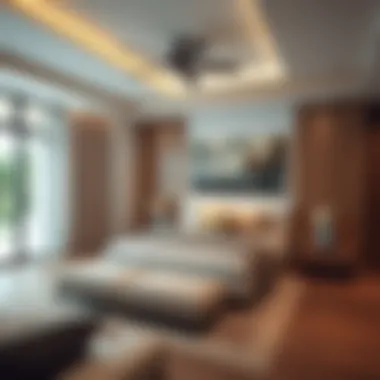Exploring Four Bedroom House Plans for Modern Living


Intro
The modern world is chock-full of diverse housing options, but few floor plans cater to a broad array of needs as effectively as the four-bedroom house. For families, expatriates, and investors alike, these spaces offer both flexibility and comfort. In this article, we will dig into the unique features, architectural nuances, and the practicality of four-bedroom house plans, guiding potential buyers through their decision-making process.
Property Listings Overview
Current Market Trends
The real estate market is like a shifting tide; it ebbs and flows based on various factors such as location, demand, and economic conditions. Lately, there’s been a noticeable shift towards larger homes, including four-bedroom houses, particularly in cities known for their luxurious lifestyles, like Dubai. This demand arises not only from families needing more space but also from investors recognizing the potential for rental income in these properties. A recent report by Knight Frank notes that luxury properties in some prime areas have seen price increases of up to 25%.
Understanding the current market dynamics is crucial. Potential buyers should be aware that the luxury real estate market is not just a bubble—it’s a reflection of a society yearning for more space and comfort. As remote work becomes the norm, families find themselves desiring homes that accommodate a work-life balance, pushing four-bedroom homes to the forefront.
Featured Properties
In this real estate landscape, several standout four-bedroom properties showcase what is achievable today:
- The Palm House in Dubai: This stunning property boasts a sleek modern design, featuring open floor plans with abundant natural light, and incorporates smart home technology.
- Urban Retreat in London: Situated in a culturally rich neighborhood, this home offers minimalist aesthetics while maintaining cozy charm, appealing actively to families and young professionals alike.
- Tropical Oasis in Bali: With traditional Balinese architecture, this four-bedroom villa incorporates high ceilings, lush gardens, and even a private pool, illustrating that four-bedroom homes can blend contemporary comfort with exotic design.
Potential buyers should stay informed on listings through trusted sites, such as Realtor.com or Zillow.com, where they can browse a variety of four-bedroom properties suited to various lifestyles.
Buying Guide
Steps to Purchase
Buying a house can feel like navigating a maze, especially when you’re after a specific layout like a four-bedroom design. Here are a few steps to consider:
- Determine Your Needs: Evaluate the priorities of your family or investment goals. This will help narrow down options, whether for active family life or income potential.
- Research Areas: Different neighborhoods bring different vibes. Consider schools, proximity to work, amenities, and safety.
- Engage a Real Estate Agent: A well-connected agent can be your compass in the current market. They can guide you to properties that meet your criteria.
- Financial Planning: Reviewing your budget and exploring various financing options will provide a clearer picture of what’s feasible.
- Home Inspections: Before finalizing a deal, a thorough inspection is necessary to avoid stepping onto shaky ground. Don’t pull the trigger without knowing the state of the property.
Key Considerations for Investors
For investors, purchasing a four-bedroom property comes with its unique considerations:
- Market Demand: Evaluate whether the area you’re considering shows consistent demand for rental properties. High vacancy rates can signify a less lucrative investment.
- Renovation Potential: A house needing a little TLC can be a goldmine if you’re skilled at renovations or have connections in the contracting world. Look for homes with good bones.
- Long-term Value: Consider whether the location has growth potential—upcoming projects or infrastructure improvements can lead to increased property values.
- Rental Income: Conduct research on average rental prices in the area to project your potential income. A well-located four-bedroom home can yield significant returns.
"Knowledge is the first step to empowerment in the real estate journey."
Make sure to explore resources like Realtor.org, Wikipedia for definitions, and Reddit to connect with others in the field.
Prelims to Four Bedroom House Plans
When one thinks about a home, a four bedroom house plan often surfaces as an ideal choice for families and individuals alike. The versatility and functionality these designs offer can cater to various lifestyles, enabling optimal family living. In the context of this article, we will explore the reasons why four bedroom house plans resonate so well within the realms of architecture, real estate, and personal comfort.
The significance of selecting the right house plan cannot be overstated. A well-thought-out design can encompass not just living space but also accommodate the emotional and social needs of a family. Families can tailor this space to create an atmosphere of togetherness while also allowing for moments of privacy. Make no mistake—having options is crucial in today’s diverse market.
Defining Four Bedroom House Plans
Four bedroom house plans typically feature four designated sleeping areas, providing ample room for family members, guests, or even a home office. While the number of rooms is a starting point, these designs often encompass a range of layouts. Some residences feature open-plan configurations that promote fluidity and interaction, whereas others lean towards more traditional, compartmentalized spaces. The layout options can be customized, enhancing the functionality according to the needs and preferences of the occupants. Furthermore, these plans may include multiple bathrooms, walk-in closets, and even dedicated spaces for hobbies or work.
Importance of Family-Centric Designs
Family-centric designs underline the essence of four bedroom house plans. Such homes provide not only physical structures but also social frameworks that foster relationships and promote well-being.
- Gathering Spaces: Living areas are often structured to invite interaction. A spacious living room or an open kitchen can serve as the heart of the home, where families build bonds over meal preparation or movie nights.
- Private Retreats: While communal areas play a role, private bedrooms offer sanctuaries for relaxation, contemplation, or study, vital for individual growth within a family dynamic.
- Function Over Form: Designing spaces with families in mind often results in practical, user-friendly layouts, reducing the chaos of daily life.
This foundational thinking highlights how a four bedroom house plan is not merely a spatial arrangement but rather a blueprint for a harmonious family life.
"Choosing a house is more than picking a roof over your head; it's about selecting a space that molds itself into your family’s narrative."
By understanding the critical role these designs play in family life, real estate professionals, investors, or homebuyers can make informed decisions. Whether investing in a property for future resale or planning a dream home, acknowledging the unique features and layout of a four bedroom house plan can spell the difference between a mere house and a loving home.
Architectural Styles of Four Bedroom Houses
In exploring four bedroom house plans, one cannot overlook the rich variety of architectural styles available. The significance of these styles goes beyond mere aesthetics; they embody cultural heritage, functional values, and even environmental considerations. An understanding of architectural styles allows buyers and builders to make informed decisions that reflect both personal taste and practical requirements. This deliberation plays a pivotal role in ensuring that a home fits well within its neighborhood while meeting the lifestyle needs of its occupants.
Contemporary Designs
Contemporary designs are often associated with modern thinking and innovative practices in architecture. They offer a fresh take on space utilization, focusing on open floor plans, large windows, and organic materials. One of the primary benefits of contemporary designs is their adaptability; as family dynamics evolve, spaces can be modified to fit new realities. For example, a spacious living area can serve as a children's play zone during the day and transform into an entertainment space at night. Moreover, these designs often emphasize energy efficiency, incorporating elements like solar panels and advanced insulation, making them appealing for eco-conscious buyers.
What sets contemporary designs apart is their ability to blend indoor and outdoor living. This connection with nature not only enhances the aesthetic appeal but also serves to promote well-being, as families are given access to natural light and fresh air.
Traditional Aesthetics


Traditional house styles evoke a sense of nostalgia and warmth, often showcasing intricate details such as crown moldings, bay windows, and gabled roofs. These designs appeal to those who appreciate heritage and timelessness. Families often find solace in traditional aesthetics, as they bring a sense of familiarity and community. For many, it’s more than just a house—it's a home filled with memories and traditions.
Many traditional designs also allow for functional flexibility. For instance, a four bedroom home can effortlessly accommodate both family needs and guest spaces. It’s also common to see expansive porches or patios that encourage interaction and connection among neighbors, fostering a sense of belonging that can be particularly valuable in suburban areas.
Modern Minimalism
On the other end of the spectrum, modern minimalism champions simplicity and functionality. Characterized by clean lines, open spaces, and a restrained color palette, this architectural style speaks to those who value clarity and order within their living environment. Minimalist homes can be particularly beneficial for families, as they reduce clutter and promote a calm atmosphere.
Employing modern materials such as concrete, glass, and steel, these homes often feature large, airy rooms with ample natural light. The aesthetic is not only about looks; it’s about creating pragmatic living spaces that serve multiple purposes. For instance, a minimalist kitchen can combine cooking amenities with social spaces, ideal for family gatherings or entertaining guests.
Mediterranean Influences
The Mediterranean architectural style draws inspiration from coastal regions, incorporating elements designed to harness the benefits of warm weather. These homes are typically distinguished by their terracotta roofs, stucco exteriors, and arched doorways. The design encourages outdoor living with spacious balconies and courtyards that create a seamless transition between the interior and exterior.
This style is not simply about looks; it often considers the climate, allowing for breezy designs to keep interiors cool. The open feel and flow of space can accommodate larger families or frequent visitors, making it an appealing choice for those who thrive on community and connection. Additionally, planting gardens with local flora is a common element, promoting sustainability while enhancing aesthetic appeal. \n> Each architectural style not only reflects preferences but also plays a vital role in enhancing lifestyle dynamics, leading to harmonious living environments that resonate with families.
Key Considerations in House Plans
When embarking on the journey of selecting a four bedroom house plan, one must tread carefully. Key considerations in house plans guide buyers and builders alike in creating spaces that cater effectively to both immediate needs and long-term aspirations. These factors not only influence the comfort and usability of the living environment but also have lasting implications for property value and marketability.
Space Utilization
In the realm of four bedroom homes, efficient space utilization stands as a cornerstone of good design. A thoughtful approach to layout can transform how a family interacts within their surroundings. Rather than merely filling rooms with furniture, space utilization focuses on maximizing functionality while adhering to aesthetic principles.
- Open Floor Plans: These designs facilitate a fluid connection between living areas, kitchen, and dining spaces, enhancing family dynamics. Open layouts can make a four bedroom house feel larger and inviting, which is particularly desirable in urban settings.
- Dedicated Zones: Allocating specific areas for purposes, such as a home office or playroom, offers practicality. This segmentation creates a sense of order, allowing family members to engage in diverse activities without interference.
- Storage Solutions: Ample storage options are essential. Built-in shelves, under-stair spaces, and well-placed cabinets can eradicate clutter and contribute to a more organized living environment.
Understanding how to balance privacy and open interaction is vital. For instance, placing bedrooms away from common areas while keeping shared spaces central creates a harmonious blend of intimacy and togetherness.
"Good design isn’t about how things look; it’s about how they work."
Future-Proofing Designs
The idea of future-proofing is increasingly pertinent in house planning. As lifestyles and family dynamics evolve, so too should the homes we inhabit. When considering four bedroom layouts, anticipating future needs can lead to smart investments and enduring satisfaction. Here are some aspects to contemplate:
- Adaptable Spaces: Look for designs that can flexibly transform to accommodate changing family sizes. For instance, a bedroom could later serve as an office or a hobby room.
- Energy Efficiency: Incorporating sustainable elements not only reduces utility costs but also aligns with growing environmental consciousness among buyers. Solar panels and high-efficiency appliances can make a home relevant for years to come.
- Technological Integration: Smart home technology offers a significant edge. By installing systems that can control lighting, security, and HVAC remotely, homeowners can enjoy convenience and enhance property value in technology-driven markets.
In essence, incorporating these future-proofing strategies into four bedroom plans signifies a commitment to sustainability, versatility, and long-term value. Homebuyers who foresee their current needs morphing into different forms in the future will appreciate these aspects immensely.
By honing in on effective space utilization and forward-thinking designs, homeowners can not only create serene living environments but also invest in intelligent choices that stand the test of time.
Essential Features of Four Bedroom Homes
When considering four bedroom house plans, one must delve deeper into essential features that significantly influence the living experience. These features cater not only to practicality but also to enhancing family quality time, creating a welcoming atmosphere, and accommodating future needs. Here, we explore various facets that define these homes, allowing potential buyers to focus on what truly matters for a balanced and functional living space.
Master Bedrooms: More Than Just A Sleeping Area
Optimal Designs
When discussing master bedrooms, the design should prioritize both comfort and functionality. Optimal designs in master bedrooms often include spacious layouts, ample natural light, and thoughtful placement of furniture. A key characteristic is the integration of personal retreat areas, such as a reading nook or a small workspace, giving the room a purpose beyond just sleeping. This concept is increasingly becoming a beneficial choice, particularly for those who wish to unwind or work from home within their private quarters.
Unique features like oversized windows or high ceilings can dramatically enhance the atmosphere, making the space feel airy and open. However, one must consider that such designs can also lead to higher costs during the construction phase, as custom elements may demand additional budgeting.
En-Suite Bathrooms
En-suite bathrooms in master bedrooms are not just about luxury—they offer significant advantages in convenience and privacy. The ability to step from bedroom to bathroom without traversing common areas can streamline morning routines and allow for more personal space. A key feature of en-suites is their design, which often includes modern fixtures and a layout that maximizes functionality. This trend is particularly popular among families and busy professionals.
A unique aspect of these bathrooms is the balance they achieve between style and practicality. Many designs feature walk-in showers and double sinks, making the bathroom a serene environment, perfect for relaxation. However, building an en-suite bathroom can increase the overall home cost, which is a consideration for prospective buyers.
Living Areas: Creating Spaces for Togetherness
Living areas in four bedroom homes ideally serve as the heart of family interaction. These spaces should be open and inviting, encouraging families to spend time together. Features such as integrated dining and living areas enable seamless transitions between activities, promoting a sense of community at home.
Wide-open layouts and versatile furnishings can help create environments that adapt to various needs, from hosting large gatherings to cozy movie nights. Moreover, connecting living spaces to outdoor areas can further enhance the experience, blurring the lines between inside and outside—truly a modern family lifestyle approach.
Kitchen Layouts and Their Importance
Kitchens today have evolved into much more than cooking spaces; they are culinary hubs where family connections are fostered. An important feature is the layout; designs such as the island kitchen or L-shaped setups are very popular, efficiently using space while allowing for interaction among family members.
Integrating modern appliances, ample storage, and counter space can make a kitchen not only practical but inviting, often turning it into a gathering spot for friends and family. Thoughtful kitchen design ensures ease of movement and increased functionality, helping to keep pace with family life.
Outdoor Spaces: Enhancing Living Experience
The value of outdoor spaces in four bedroom houses cannot be overstated. A well-designed patio or garden can significantly enhance the overall living experience. Features like outdoor seating areas, built-in grills, and garden spaces allow homeowners to enjoy nature right at home, facilitating relaxation and recreation.


These outdoor areas provide room for kids to play or for family barbecues, promoting a balanced lifestyle that includes both indoor and outdoor experiences. However, the maintenance aspect is something to consider, as it can become demanding without proper planning and landscaping.
"A well-planned home is a haven where families thrive. Rule of thumb—think ahead, plan ahead."
For more insights on house features, you can refer to This Old House or resources from Architectural Digest.
Customization Options for Four Bedroom Houses
When it comes to crafting a home that truly reflects personal taste and lifestyle, customization options for four bedroom houses stand out as crucial. These options allow homeowners to mold their living space to suit individual preferences, ensuring that the house not only meets functional needs but also embodies aesthetic desires. For families, this flexibility leads to environments that foster comfort and efficiency. Here, we will explore two vital areas of customization: interior finishes and materials, and smart home technology integration.
Interior Finishes and Materials
Choosing the right interior finishes and materials can make or break the ambiance of a home. From flooring to wall coverings, the selections contribute to both the visual appeal and the durability of a living space.
- Flooring Options: Homeowners have wide-ranging choices. Hardwood floors infuse warmth, while sleek tiles can offer a modern touch. Carpeting may suit bedrooms for coziness, while luxury vinyl tiles provide a cost-effective and waterproof solution for high-traffic areas.
- Wall Finishes: Paint color and texture are cornerstone decisions. Subtle hues can create a calm atmosphere, while bold colors can add vibrancy. Textured finishes like wallpaper or shiplap can introduce character and depth to living spaces.
- Cabinetry and Countertops: In kitchens and bathrooms, the choice of cabinetry—which can range from classic wood to contemporary laminates—along with countertops, significantly impacts functionality and style. Quartz and granite are revered for their durability, while eco-friendly materials offer sustainable options.
- Lighting Fixtures: The right lighting can transform a room. Customizable options, including track lighting to pendant fixtures, allow homeowners to enhance mood and functionality, effectively highlighting architectural features or artwork.
Utilizing these interior finishes and materials not only refines the aesthetic value of a four bedroom house but also plays a crucial role in setting the tone for family gatherings, everyday living, and relaxation.
Smart Home Technology Integration
In today’s fast-paced world, integrating smart home technology into four bedroom houses is no longer just a trend; it’s becoming standard. This customization option brings remarkable benefits, enhancing not only convenience but also security and energy efficiency.
- Home Automation Systems: Systems like Amazon Alexa or Google Home can control everything from lighting to thermostats, providing ease of use. Imagine walking into your home and having the lights adjust and your favorite music play—all with a simple command!
- Security Features: Enhanced security systems with smart cameras and alarms can offer peace of mind. Homeowners can monitor their properties live from anywhere through smartphone apps, ensuring safety even when away.
- Energy-Efficient Solutions: Smart thermostats learn homeowner habits and adjust heating or cooling accordingly, which can lead to significant savings on utility bills. Smart blinds can also help manage heat from the sun, contributing to sustainability.
- Integrated Entertainment Systems: Customizing audio-visual setups can elevate family movie nights or gatherings. Options range from multi-room speakers to home theaters, tailored according to the homeowner’s preferences.
Incorporating smart home technology not only modernizes a four bedroom house but also aligns with a tech-savvy lifestyle that many families pursue today.
Overall, embracing customization options significantly enhances the appeal and functionality of four bedroom houses, making them not just structures but true homes tailored to the occupants' desires.
The Process of Selecting a Four Bedroom House Plan
Selecting a four bedroom house plan is not a task to be taken lightly. With different choices available, a meticulous approach is essential for ensuring that your new home meets both current and future needs. The decisions made during this phase not only affect the buying experience but also impact how the family interacts within the space over the years to come.
The process typically begins with a careful assessment of your unique needs. It’s important to evaluate how many family members will live in the home and what their daily routines are like. This might include considering if you have teenagers who prefer their own space or younger children who might benefit from proximity to the parents' room. Some may even be looking at the potential for future family expansions or changes in lifestyles. Having a clear picture of all these factors will provide a sturdy foundation for making a wise choice that supports your family dynamics.
Assessing family needs leads to informed decisions, shaping a house that feels less like a structure and more like a home.
Assessing Family Needs and Lifestyle
When evaluating a four bedroom house plan, understanding family needs and lifestyle cannot be overstated. This phase is about looking beyond just the aesthetics or current trends; it is about how your family functions day to day.
First, consider the daily rhythms and activities of your family. Does anyone work from home? If so, a quiet space for an office is crucial, ideally separated from the main living areas. Likewise, if children are part of your household, their needs should shape the design. For instance, a playroom that doubles up as a study space might keep distractions at bay while ensuring homework gets done. And let’s not forget those family gatherings. An open floor plan variants can facilitate social interactions when family and friends come around for a dinner party.
Also, think about long-term adaptability. For example, a four bedroom house can easily accommodate not just immediate family but also aging parents or guests if the design considers functionality. With the right adjustments in space allocation, you could use one of the bedrooms as a guest room or a caretaker's suite when the need arises.
Working with Architects and Designers
Once you have a better grasp of your family’s needs, collaboration with architects and designers is the next step. This can be quite pivotal in transforming your vague ideas into tangible designs. Working with professionals who understand your vision can yield options that you might not have considered otherwise.
Do your homework and find architects who specialize in residential designs with four bedroom configurations. Schedule consultations to communicate essential features that are important for you. Would you prefer built-in storage solutions? Participation areas? Energy-efficient layouts? All of these preferences should be on the table.
Don’t forget to ask about their prior projects! A walk-through of previously completed homes can spark ideas while ensuring you are comfortable with their style and approach. And as you communicate your preferences, it’s wise to remain open to their expert suggestions, as they might offer alternate ideas that modestly revamp your original vision.
Market Trends in Four Bedroom Properties
Understanding the market trends for four bedroom properties is crucial for anyone involved in real estate, whether you are a seasoned investor or looking to buy a home for your family. These trends provide insights into what prospective buyers are searching for, what builders are focusing on, and how different features can influence property values. To effectively navigate this landscape, it is essential to comprehend the demand and supply dynamics, as well as the investment potential in luxurious markets.
Demand and Supply Dynamics
The demand for four bedroom houses can fluctuate due to various factors including economic conditions, demographic shifts, and even lifestyle changes. In many urban areas, families are increasingly looking for houses that offer ample living space. A growing population, particularly in places like Dubai, coupled with shifting preferences for home environments, heightens the competition for spacious properties.
- Key factors influencing demand:
- Population growth in urban areas
- Shift to remote work, allowing more families to seek larger homes
- Rising disposable incomes, enabling higher spending on housing
Supply, on the other hand, is often limited by strict zoning laws and land availability. For instance, if a region has stringent regulations regarding new constructions, it can lead to a marked shortage of four bedroom houses. Understanding this interplay allows buyers and sellers to make informed decisions.
"Inventory levels are critical; too few homes lead to inflated prices, while excess supply can create a buyer's market."
Investment Potential in Luxurious Markets
Four bedroom homes in luxurious markets have shown resilience, even during economic downturns. These properties often appreciate at a faster rate than smaller homes due to their inherent desirability among affluent buyers. As such, investing in a four bedroom house can be more than just a home—it's a viable asset.


- Advantages of investing in four bedroom luxury homes:
- Higher rental yields: Particularly in popular expat areas or tourist destinations, larger homes can attract premium rents.
- Longer-term appreciation: Luxury properties have a history of value appreciation, especially in sought-after neighborhoods.
- Attractiveness to diverse demographics: Given their size, these homes appeal not just to large families, but also to multi-generational living or investors looking for vacation rentals.
Benefits of Four Bedroom House Plans
When it comes to choosing a home, particularly in the realm of four bedroom properties, the benefits go beyond mere square footage. These homes offer unique configurations that support modern family life and investment. The discussions herein will emphasize why opting for a four bedroom house plan can be a definitive game-changer.
Flexibility for Families
One significant advantage of four bedroom houses is their inherent flexibility. Families often evolve over the years, which necessitates spaces that can adapt to changing needs. Whether it's accommodating new children, hosting relatives, or establishing a dedicated workspace, a four bedroom layout provides room to grow.
A common use for an extra bedroom is creating a guest room. The ability to host relatives during holidays or unexpected guests adds a warmth to family life that many cherish. Moreover, children often need spaces of their own as they grow. Transforming a bedroom into a playroom or study underscores the versatile nature of these plans.
Here are some common uses of a four bedroom layout:
- Dedicated Home Office: As remote work becomes prevalent, having a separate space for work can enhance productivity and maintain boundaries between personal and professional life.
- Hobby or Craft Rooms: This can be a sanctuary for those looking to explore artistic pursuits, whether it be painting, crafting, or any other passion.
- Storage Solutions: Four bedrooms also allow homeowners to create efficient storage spaces, which can be especially valuable in maintaining an organized home.
A well-designed four bedroom house can serve as more than just a dwelling—it can become a nurturing space that fosters family bonds and individual growth.
Potential for Rental Opportunities
The other noteworthy benefit of four bedroom house plans revolves around their potential as income generators. The increasing trend toward flexible living arrangements has opened avenues for homeowners to capitalize on their properties. Four bedroom homes can attract potential renters looking for more space, particularly in urban areas.
In many regions, renting out a room or two can cover a substantial portion of mortgage payments. This form of passive income can make owning a larger home financially feasible, helping to balance expenses. Also, properties designed with separate entrances or layouts that support privacy can be particularly appealing for those looking to rent out rooms.
Consider these rental opportunities related to four bedroom properties:
- Long-term Rentals: In popular markets, families seeking more space are often willing to pay a premium for well-located properties.
- Vacation Rentals: With the rise of platforms like Airbnb, four bedroom homes can be marketed as short-term stays, catering to tourists or those seeking temporary housing.
- Roommate Scenarios: Young professionals or college students often look for shared living arrangements, making a four bedroom home an ideal candidate for multiple occupants.
Navigating rental markets efficiently can further enhance the appeal of four bedroom plans. Whether for investment or personal use, these homes offer robust opportunities in a changing housing economy.
Challenges in Designing Four Bedroom Properties
Designing a four-bedroom house is not merely a matter of arranging spaces; it involves navigating a maze of challenges that can make or break a project. For real estate agents and investors, understanding these challenges is pivotal. Emerging trends in family living demand flexibility and foresight. Addressing design difficulties ensures that properties are not only desirable but also functional and compliant with local laws.
Zoning Laws and Regulations
When contemplating a four-bedroom property, zoning laws represent a significant hurdle. These regulations can dictate not just the layout but also the type of construction permissible in a certain area. In many locales, zoning laws are designed to maintain a sense of community and order, rather than to stifle creativity.
- Permitted Uses: Each zone allows specific types of buildings—residential, commercial, or mixed-use. If a property is in a strictly residential zone, plans for a four-bedroom house could be scrutinized for adequacy in relation to the size and scale of neighboring homes.
- Height Restrictions: Some areas impose height limits which can restrict splendid designs with second stories or expansive ceilings. If a plan doesn’t fit within these parameters, revisions will be necessary, often leading to increased costs.
"Zoning laws, while often seen as barriers, can become catalysts for creativity, urging designers to think outside the box within set constraints" — Unknown
- Setback Requirements: These dictate how far a building must be from property boundaries. Failing to comply could mean that dream layouts need complete overhauls. Therefore, it’s crucial for designers to be well-versed in local zoning regulations before setting pencil to paper.
Balancing Space and Cost
In an ideal world, every aspiration of a four-bedroom house would come to fruition. However, the hard reality often reveals that balance is key. Striking a harmony between spacious design and budget constraints is no easy feat.
- Prioritize Layout: A well-thought-out layout can enhance the perception of space, even in smaller homes. This means investing time in creating open-concept areas that allow for seamless transitions between living spaces.
- Material Selection: The choice of materials can greatly affect both cost and aesthetics. Investing in quality materials that resonate with the desired style while remaining within budget is paramount. Designers must weigh the long-term benefits of higher-quality finishes against upfront costs.
- Function Over Aesthetics: While fancy fixtures and trendy designs are appealing, they often come with hefty price tags. Emphasizing functionality alongside aesthetics can lead to designs that serve families well without overwhelming their budgets.
Epilogue and Future Insights
In wrapping up our exploration of four bedroom house plans, it's clear that these designs offer a perfect blend of functionality and flexibility that caters to diverse family needs. This topic is paramount as it touches upon the evolving landscape of family living, lifestyle changes, and broader market trends. Amidst fluctuating demands, understanding the elements that influence home design today can greatly impact future investments and buying decisions.
With the rising awareness of environmental concerns, sustainability emerges as a critical topic in future designs. This aspect not only aims to reduce carbon footprints but also enhances the quality of living spaces. By incorporating eco-friendly materials and energy-efficient technologies, future house plans will not only be viable options for families but can also lead to long-term savings.
As demand for four bedroom homes grows in areas like Dubai, where many expatriates are eager to settle, they must consider how these factors influence their choices. Below, we dive into the specific elements that warrant attention in our modern housing landscape.
Sustainability in Future Designs
Sustainability is no longer a buzzword; it's become a necessity. As buyers become more environmentally conscious, house plans that integrate green building materials and energy-efficient systems will stand out. Features such as solar panels, rainwater harvesting systems, and high-efficiency insulation are increasingly sought after. Here are key benefits:
- Energy Savings: Long-term reductions in energy bills can be significant with sustainable designs.
- Healthier Living: Non-toxic materials and improved air quality contribute to better health for occupants.
- Regulatory Benefits: Many regions provide tax incentives or grants for green home projects, adding financial incentive for families.
Implementing such designs not only addresses personal needs but also aligns with a growing global emphasis on environmental stewardship.
Evolving Preferences in Homebuyers
As society shifts, so do the expectations of homebuyers. Today, the focus is not solely on square footage or the number of bedrooms. Buyers are prioritizing flexible spaces that encourage functionality. With remote work on the rise, for instance, the demand for home offices is soaring. Families now desire:
- Multi-functional Rooms: Areas that can serve as playrooms, offices, or guest rooms are in demand.
- Outdoor Living Spaces: Balconies, patios, or gardens that offer an escape from indoor environments are gaining popularity.
- Smart Home Technology: Homebuyers are increasingly looking for homes that offer technology integration, enhancing efficiency and comfort.
Overall, understanding these evolving preferences is crucial for real estate agents, investors, and developers alike. As demographics change, being attuned to these shifts can lead to successful investments and satisfied clients.
"The homes we choose not only define our living spaces but also shape the future of our communities."
For more insights on real estate trends, you can refer to Wikipedia, or explore discussions on platforms like Reddit.
Explore further at Britannica for comprehensive information.







